24 Wild Animals in Zimbabwe [Wildlife in Zimbabwe]
Want to know more about the wildlife of Zimbabwe?
Discover 24 wild animals in Zimbabwe in this post, as well as interesting facts about them. 🇿🇼
Learn All About Zimbabwean Animals
Ready to learn all about Zimbabwean animals?
I’ve always been fascinated by animals, and by how they can be so different from one country to another. In this guide, we’ll focus on the many animals Zimbabwe has on the land, in the sky, and underwater.
I’ve split the guide into 4 categories:
- Native animals from Zimbabwe
- Endangered animals of Zimbabwe
- What is Zimbabwe national animal?
- How many animals native to Zimbabwe?
Let’s dive in right away with our first category!
Native Animals from Zimbabwe
Zimbabwe is a landlocked African country located in the southern part of the continent, on the eastern side of the continent. It has 16 official languages, became a major trade route during the 11th century, used to be ruled by a dictator until 2017, suffered a 15-year-long guerilla war, and used to be a British colony. It is bordered by South Africa, Botswana, Mozambique, and Zambia, and its capital and largest city is Harare, which counts more than 2,013,000 inhabitants (but more than 3,120,000 if you include the metropolitan area).
An interesting part of the country that I wanted to tackle is its wildlife. In light of that, I have listed the best of it, and I hope you will love learning what animals live in Zimbabwe.
Here’s the Zimbabwe animals list.
1. African bush elephant
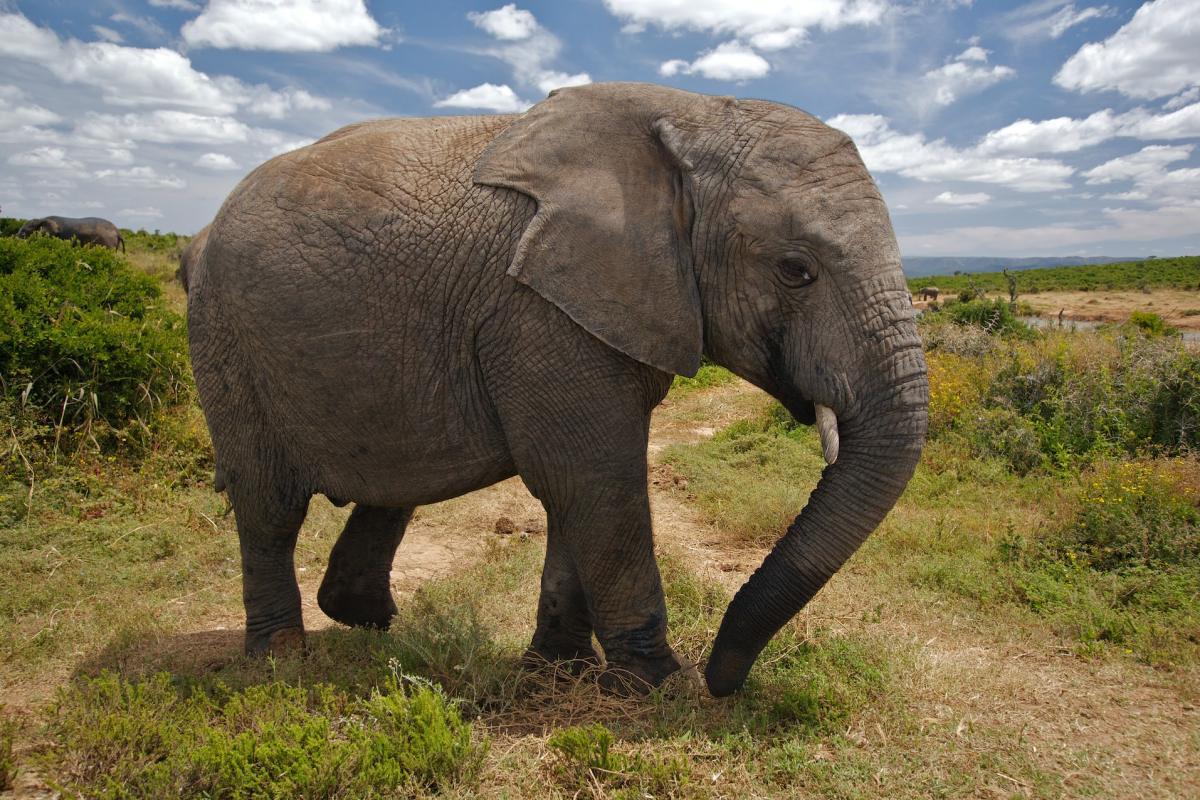
- Name: African bush elephant
- Scientific name: Loxodonta africana
- Conservation status:
The African bush elephant, also known as the African savanna elephant, is the largest terrestrial animal in the world. It is heavily poached for its ivory and suffers from habitat loss, which is why it is considered endangered.
This fantastic creature can be found across much of sub-Saharan Africa, although its populations are fragmented. It inhabits subtropical and temperate forests, as well as the wetlands and grasslands of Zimbabwe.
2. African leopard
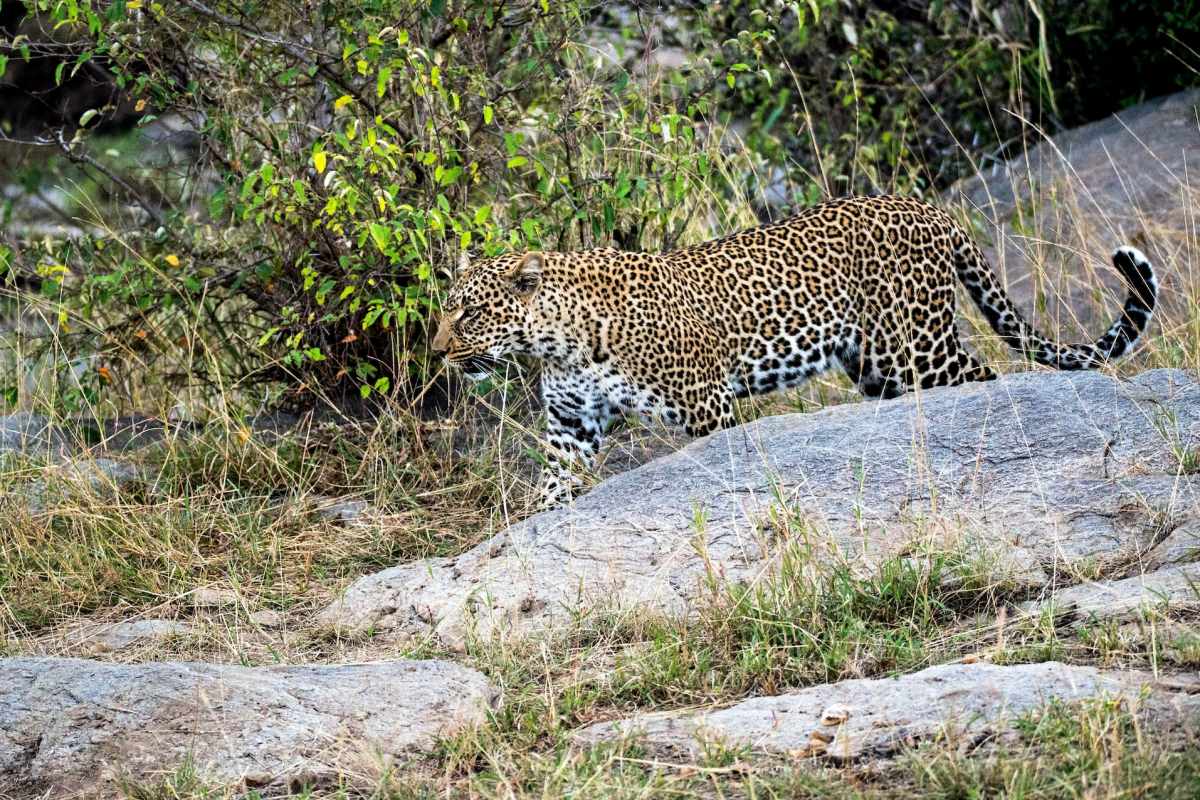
- Name: African leopard
- Scientific name: Panthera pardus pardus
- Conservation status:
The African leopard is the most widespread and common subspecies of the leopard. It can be found throughout much of sub-Saharan Africa and is one of the most iconic animals in the entire continent.
This big cat can tolerate a wide variety of habitats, from grasslands and savannas to mountainous forests; it also feeds on whatever is available, although it usually hunts for ungulates such as antelopes or wildebeests.
3. Spotted hyena
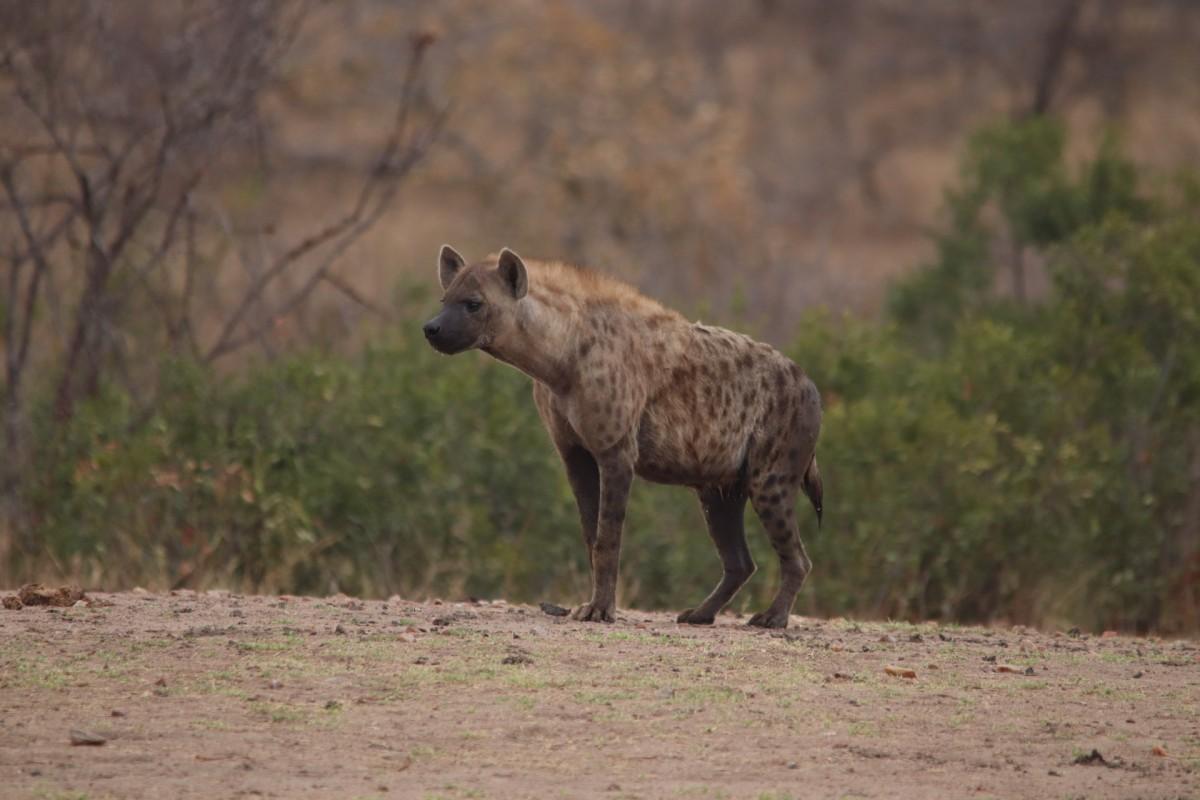
- Name: Spotted hyena
- Scientific name: Crocuta crocuta
- Conservation status:
The spotted hyena, also known as the laughing hyena, is a species of hyena native to sub-Saharan Africa, where it is widespread and common; in fact, it is the most common large carnivore in the entire continent, thanks to its opportunism and extremely high versatility.
This mammal has had a long history of interactions with humans, and it is often seen as ugly and cowardly, or even stupid, gluttonous, and dangerous.
4. Serval
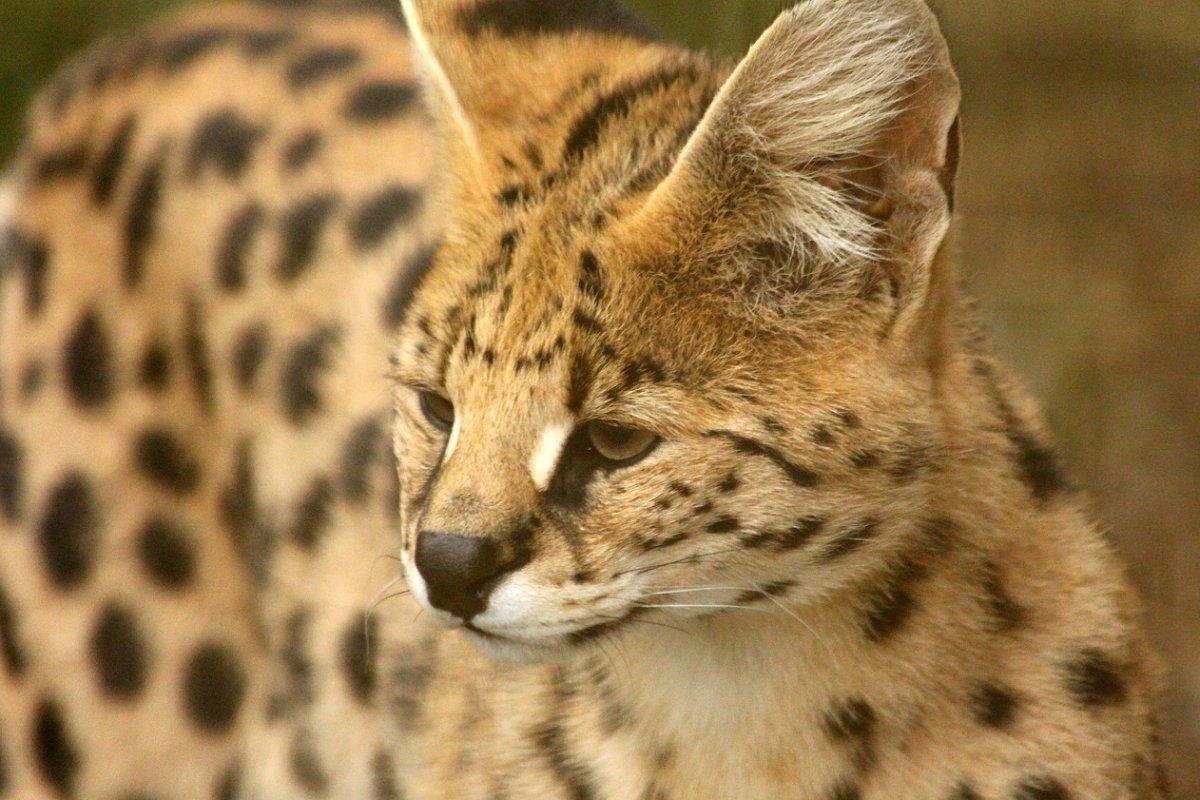
- Name: Serval
- Scientific name: Leptailurus serval
- Conservation status:
The serval is a species of wild cat native to Africa. It is spread throughout much of the continent and is one of the rare cat species to be considered of least concern, due to its range mostly being within protected areas.
This cat can be found in the grasslands and moorlands of Zimbabwe and can be found as high as 3,800 m / 12,500 ft above sea level.
5. Sharpe’s grysbok
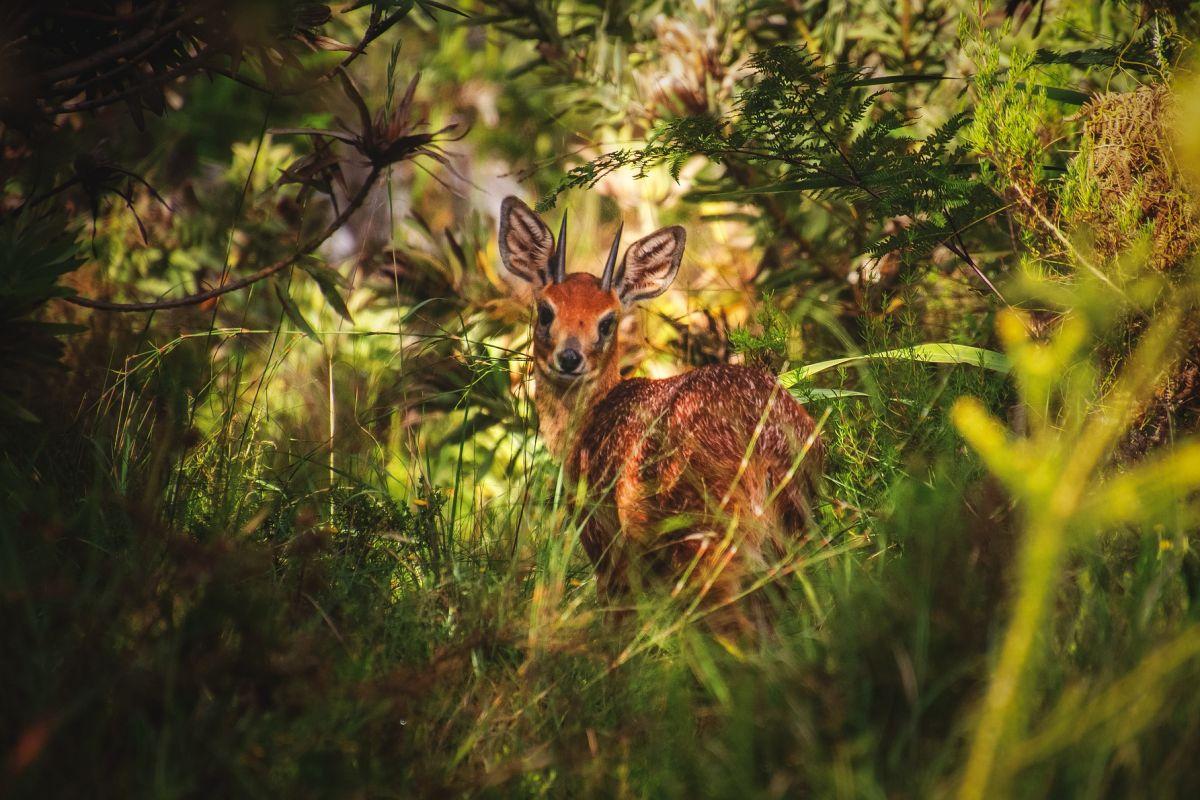
- Name: Sharpe’s grysbok
- Scientific name: Raphicerus sharpei
- Conservation status:
Sharpe’s grysbok, also known as the northern grysbok, is a small species of antelope found in tropical and southeastern Africa. It is particularly shy and solitary and is thus very difficult to spot. It can be found in countries such as Zimbabwe, Zambia, Tanzania, and Mozambique, where it lives in the rocky hill country.
When it comes to feeding, Sharpe’s grysbok prefers herbs, leaves, buds, and fruits, as well as grasses.
6. Black-backed jackal
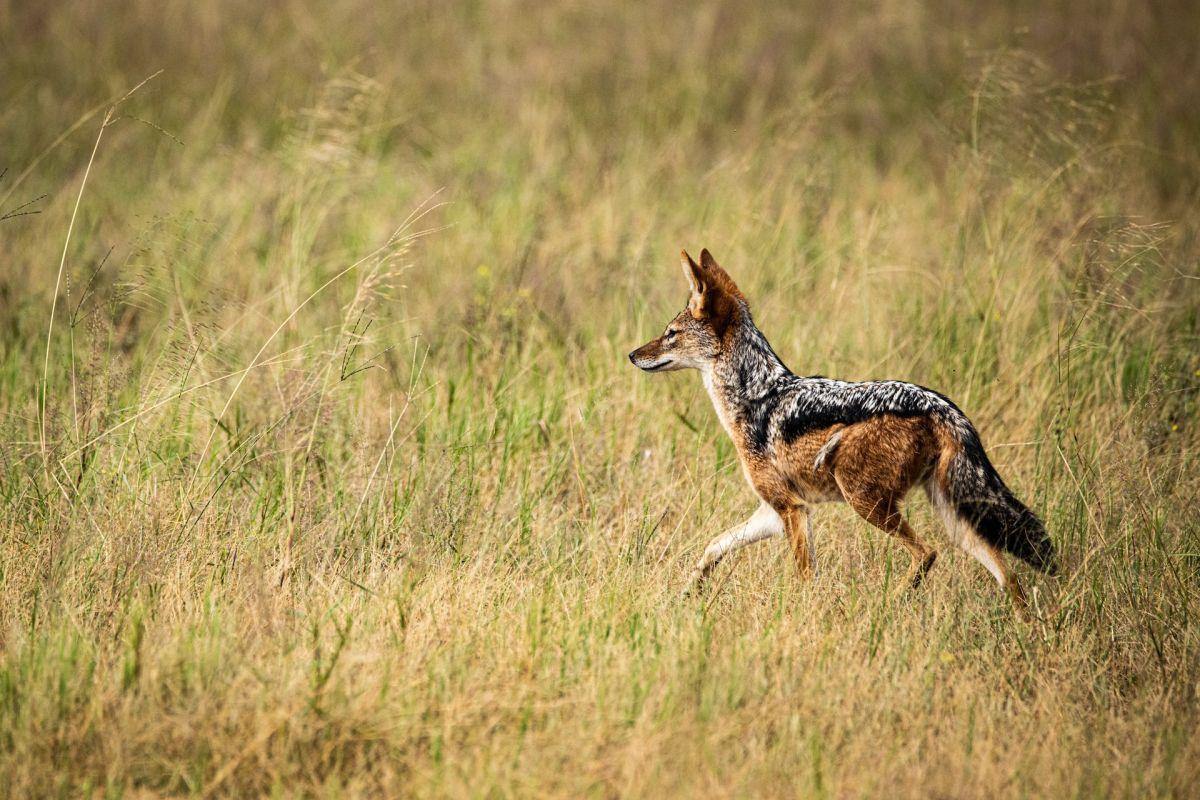
- Name: Black-backed jackal
- Scientific name: Lupulella mesomelas
- Conservation status:
The black-backed jackal is a medium-sized species of canine native to southern and eastern Africa, with a range expanding over about 900 km / 560 mi in length. There is a local subspecies in Zimbabwe known as the Cape black-backed jackal.
This canine is territorial and forms life-long pairs. It has a gestation period of 60 days, and mates from late May to August. It prefers open areas with little vegetation, where it hunts for scorpions, hares, and birds, but also feeds on fruits and berries.
7. Southeast African cheetah
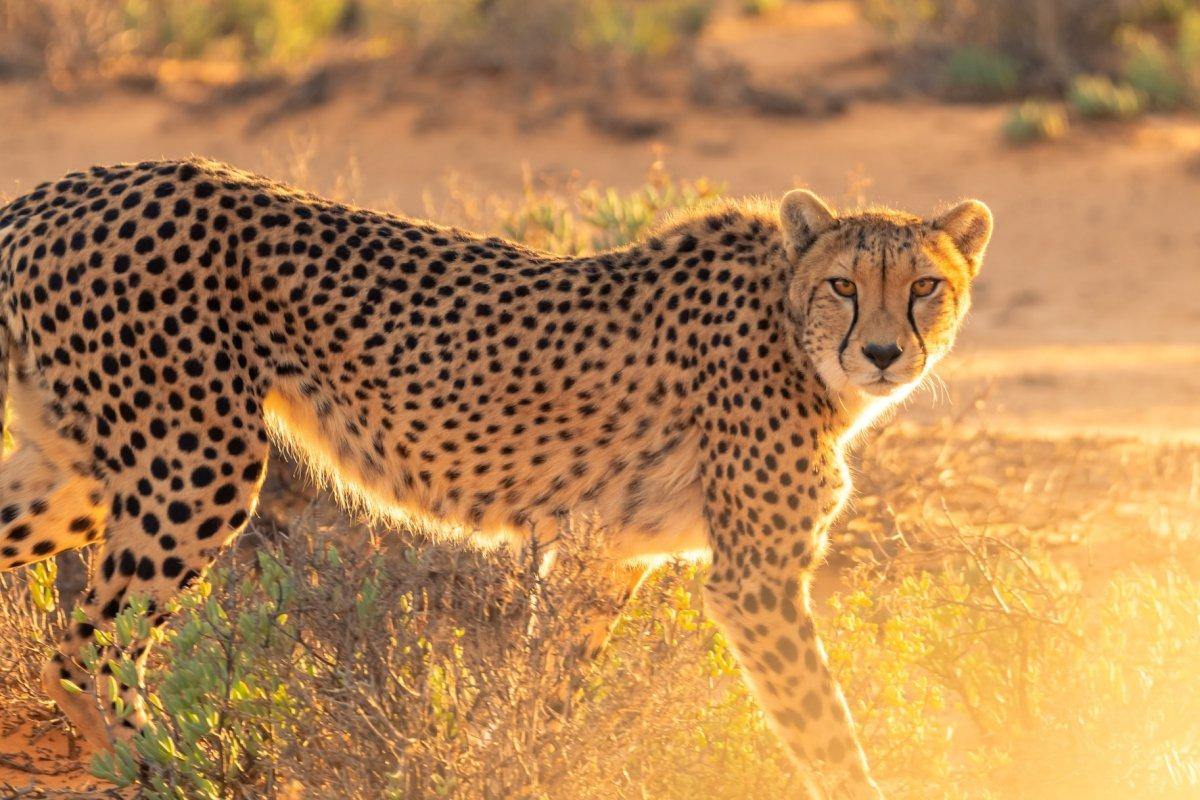
- Name: Southeast African cheetah
- Scientific name: Acinonyx jubatus jubatus
- Conservation status:
The Southeast African cheetah is a subspecies of cheetah found in sub-Saharan Africa. It mainly lives in the desert of the Kalahari, the Okavango Delta, and the Transvaal region, but can also be found in countries such as Zimbabwe.
In fact, Zimbabwe is one of the few countries to be home to king cheetahs, a rare variant of the cheetah. Sadly, there were about 1,000 individuals in Zimbabwe, but there are now fewer than 165.
8. Southern African lion
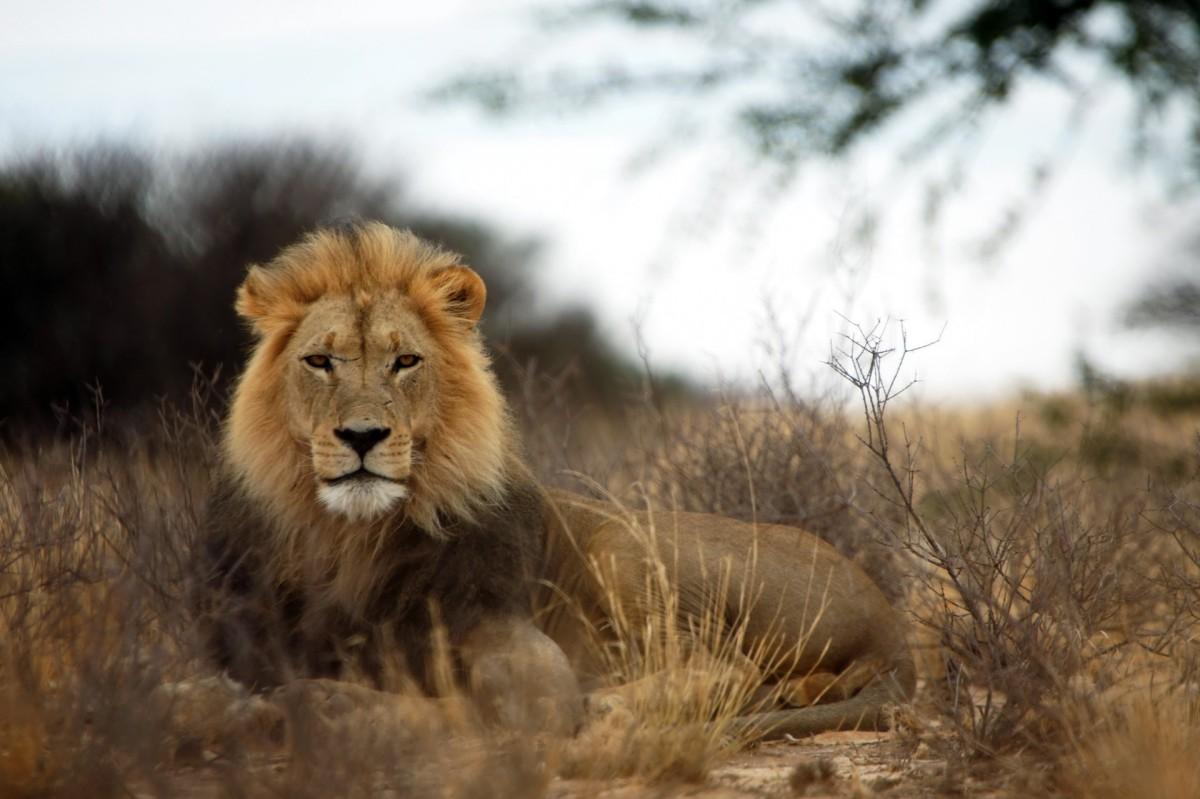
- Name: Southern African lion
- Scientific name: Panthera leo melanochaita
- Conservation status:
The Southern African lion, also known as the Southern lion, is a subspecies of the king of the jungle which can be found in eastern and southern Africa. It is seriously threatened by depletion of prey, poaching, and habitat fragmentation and loss, and is a popular prize for trophy hunting.
Trophy hunting is one of the major causes of the decline of the Southern African lion in Zimbabwe, although it usually lives in protected areas.
9. Lesser wooly bat
- Name: Lesser wooly bat
- Scientific name: Kerivoula lanosa
- Conservation status:
The lesser wooly bat is a small species of vesper bat found in Zimbabwe, the Democratic Republic of the Congo, the Ivory Coast, Ghana, and Botswana, among many other African countries. It usually inhabits subtropical or tropical moist lowland forests, as well as moist and dry savanna.
This bat often stays near water, and it sometimes roosts in bird nests, which provides protection from nature and predators; there are 1 to 3 bats per nest on average.
10. Burchell’s zebra
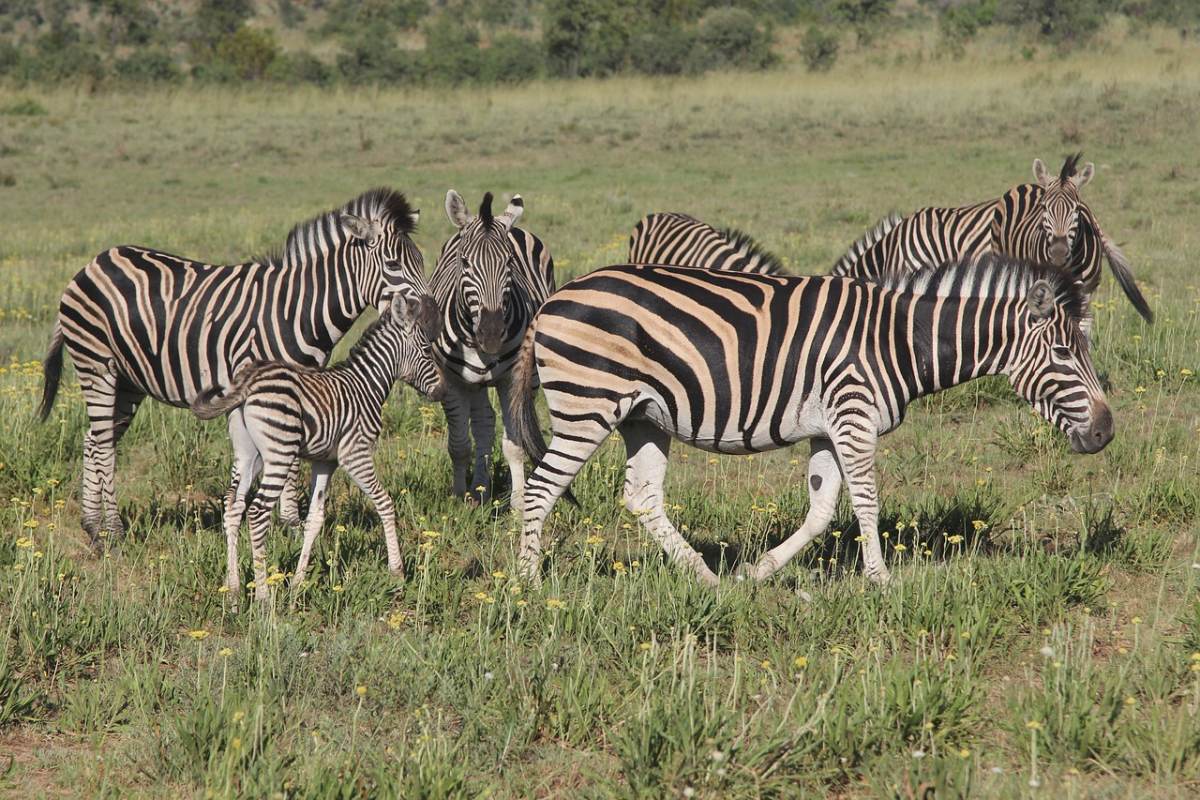
- Name: Burchell’s zebra
- Scientific name: Equus quagga burchellii
- Conservation status:
Burchell’s zebra, also known as the Damaraland zebra, the bonte quagga, or the Zululand zebra, is a subspecies of the plains zebra found in southern Africa. It is one of the most common zebras in the world, and the only subspecies which can legally be farmed for consumption.
Female and male Burchell’s zebras are about the same size, just like other zebras. They live in small family groups, either bachelor or harem groups.
11. Black-footed cat
- Name: Black-footed cat
- Scientific name: Felis nigripes
- Conservation status:
The black-footed cat, also known as the small-spotted cat, is the smallest species of wild cat in all of Africa, measuring only up to 52 cm / 20 in in length. Despite its name, only the soles of its feet are either dark brown or black.
Thanks to its spotted fur, the black-footed cat is well camouflaged, especially during the night. It can only be found in southern Africa and inhabits the open, dry savannas and the shrublands with higher grasses of Zimbabwe.
12. Cape wild dog
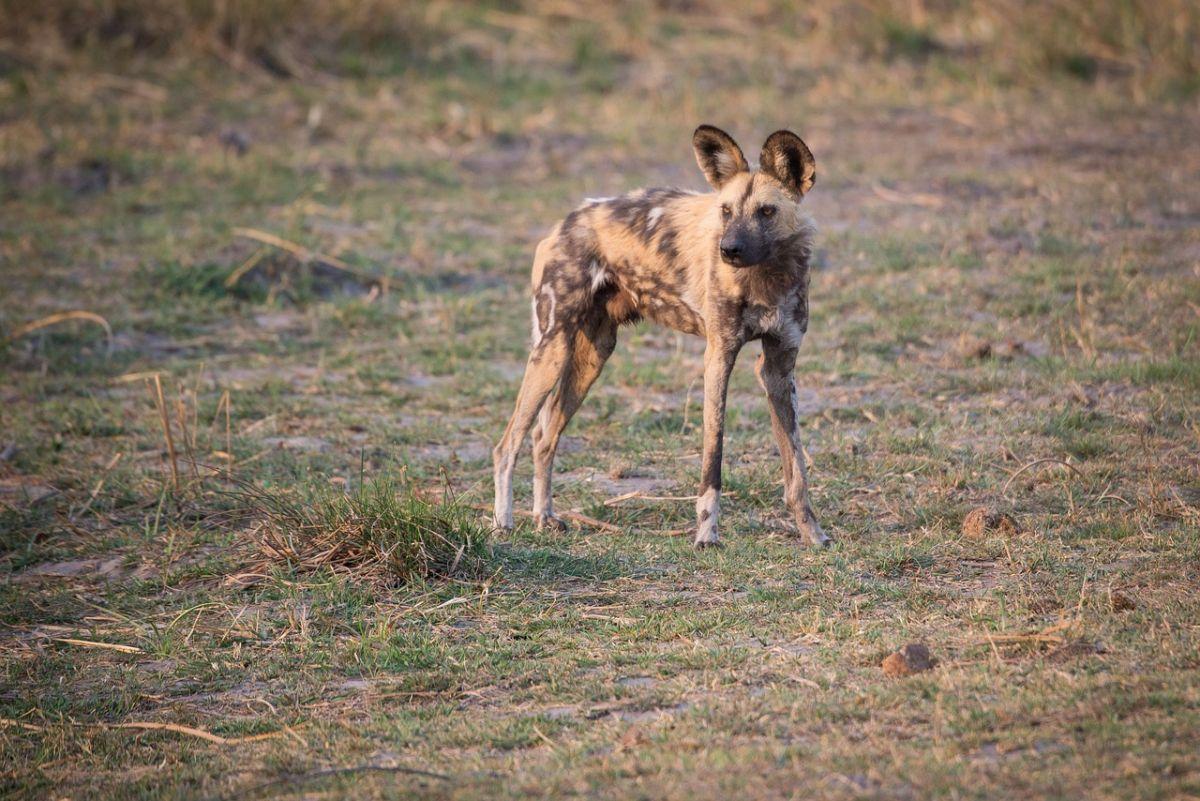
- Name: Cape wild dog
- Scientific name: Lycaon pictus pictus
- Conservation status:
The Cape wild dog is the largest subspecies of the African wild dog, also known as the African painted dog or the African hunting dog. It is a wild canine found in much of southern Africa, and specializes in day-time hunting of antelopes, by chasing them to exhaustion.
This canine has a large amount of orange-yellow fur overlapping the black, and mostly yellow underparts with whitish hair on its throat mane.
13. Southern African hedgehog
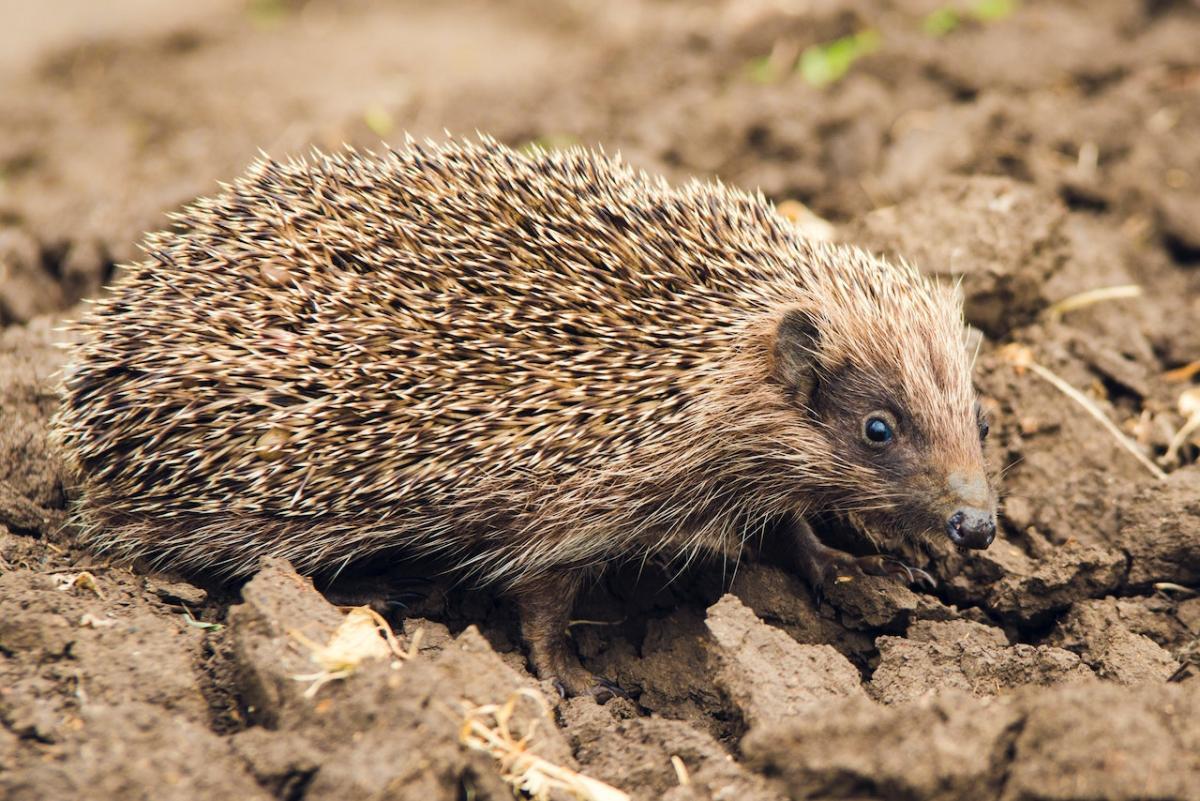
- Name: Southern African hedgehog
- Scientific name: Atelerix frontalis
- Conservation status:
The Southern African hedgehog is a species of mammal native to Zimbabwe, South Africa, Angola, Botswana, Tanzania, Namibia, and Lesotho. Just like other hedgehogs, its body is covered by sharp spines known as quills.
This hedgehog is a slow mover but can run pretty fast when threatened. When resting, it curls up into a ball and becomes practically impossible to attack. It is an insectivorous animal, which feeds on crickets and earthworms, as well as human refuse and lizards.
14. Bateleur
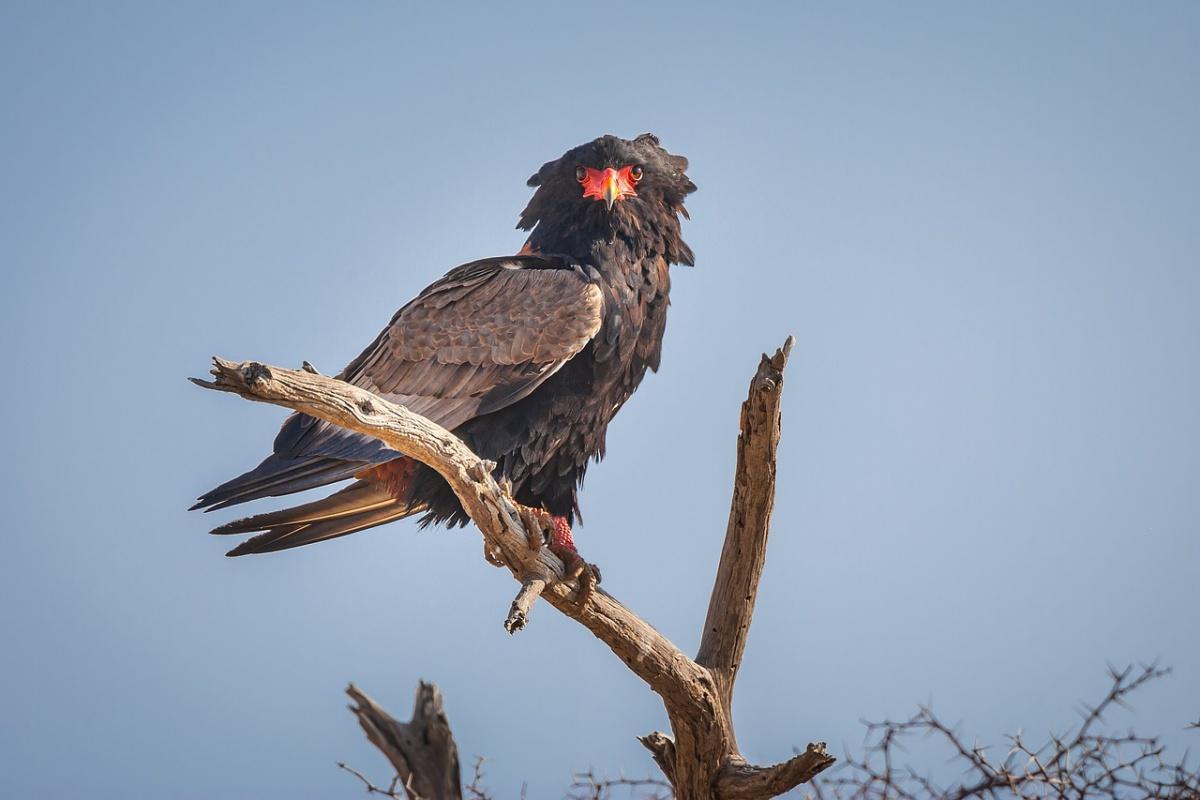
- Name: Bateleur
- Scientific name: Terathopius ecaudatus
- Conservation status:
The bateleur eagle is the national bird of Zimbabwe. It is a medium-sized species of eagle with a characteristic, striking red face and cere. It is most likely the origin of the Zimbabwe Bird, which is the national emblem of the country.
In Zimbabwe, the bateleur is relatively common but avoids the majority of the country, which is made of rugged and hilly areas. Across its range, it has decreased by about 75 percent, mostly due to habitat destruction, poisoning of carcasses, pesticide use, and persecution.
15. African bullfrog
- Name: African bullfrog
- Scientific name: Pyxicephalus adspersus
- Conservation status:
The African bullfrog, also known as the pixie frog, is a species of frog found in Zimbabwe, Botswana, Kenya, and Angola, among others. It inhabits the moist savannas, subtropical or tropical dry shrublands, and freshwater lakes and marshes of Zimbabwe, and is an exotic pet in many countries around the globe. It can live for 35 years in captivity!
Female African bullfrogs lay about 3,000 to 4,000 eggs at once, and tadpoles hatch after 2 days, feeding on small fish, invertebrates, and… each other.
16. Common ostrich
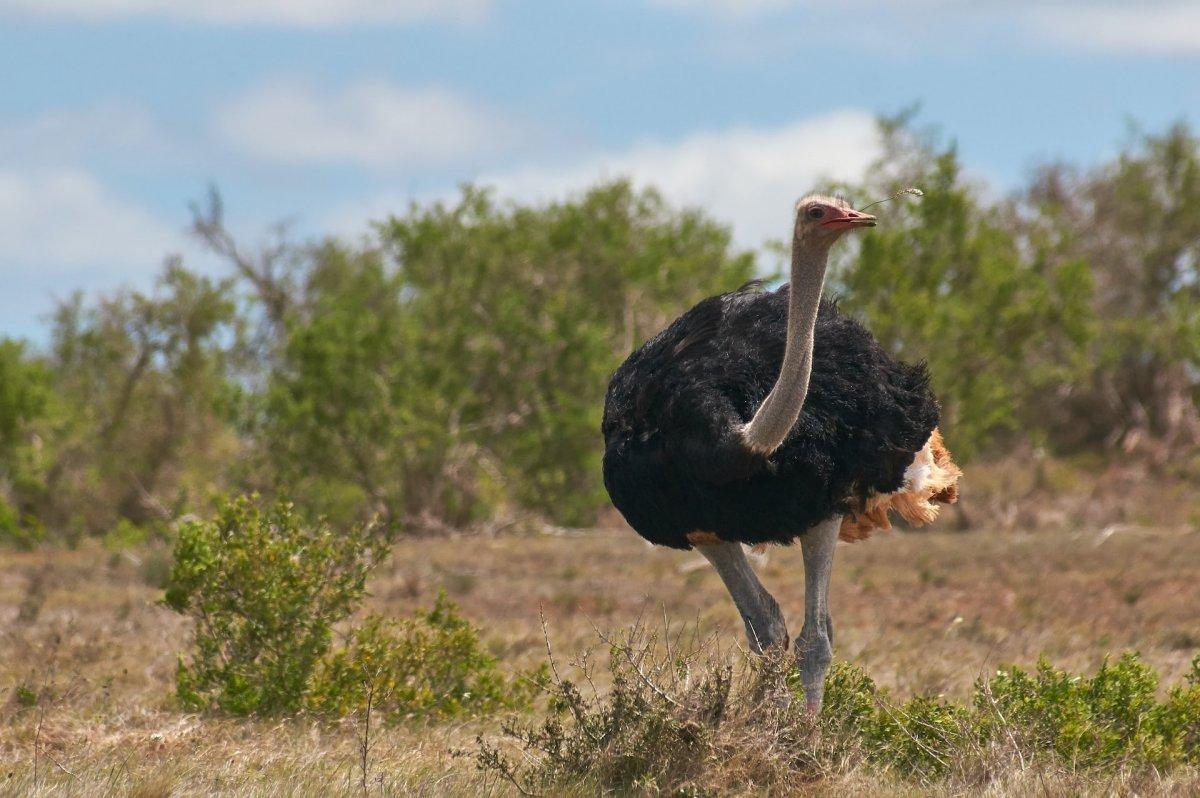
- Name: Common ostrich
- Scientific name: Struthio camelus
- Conservation status:
The common ostrich, also simply known as the ostrich, is a large species of flightless bird native to several areas of sub-Saharan Africa. It is the largest bird in the world and can reach fantastic speeds of up to 70 km/h / 70 mph as compensation for its inability to fly.
When it comes to feeding, the common ostrich can eat plant matter, but also small reptiles and invertebrates. Usually, it gathers in nomadic groups of 5 to 50 individuals, and it is farmed around the world for its feathers, skin, and meat.
17. Gray crowned crane
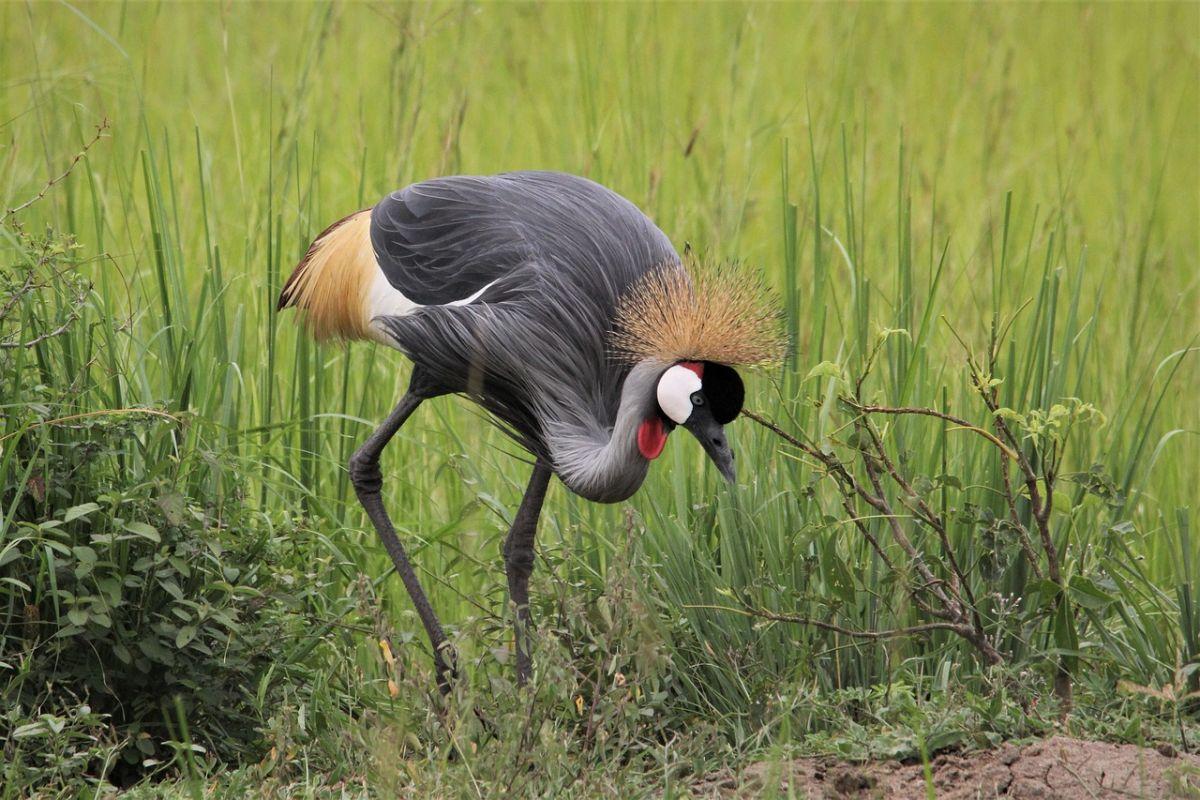
- Name: Gray crowned crane
- Scientific name: Balearica regulorum
- Conservation status:
The gray crowned crane, also known as the South African crane, the crested crane, the Kavirondo crane, or the African crowned crane, is a species of bird native to eastern and southern Africa. Within its range, it is a very well-known animal and a prominent symbol in local culture and folklore.
It is named after the stiff golden feathers on top of its head, and it inhabits the dry savannas of Zimbabwe and the rest of sub-Saharan Africa.
18. Southern reedbuck
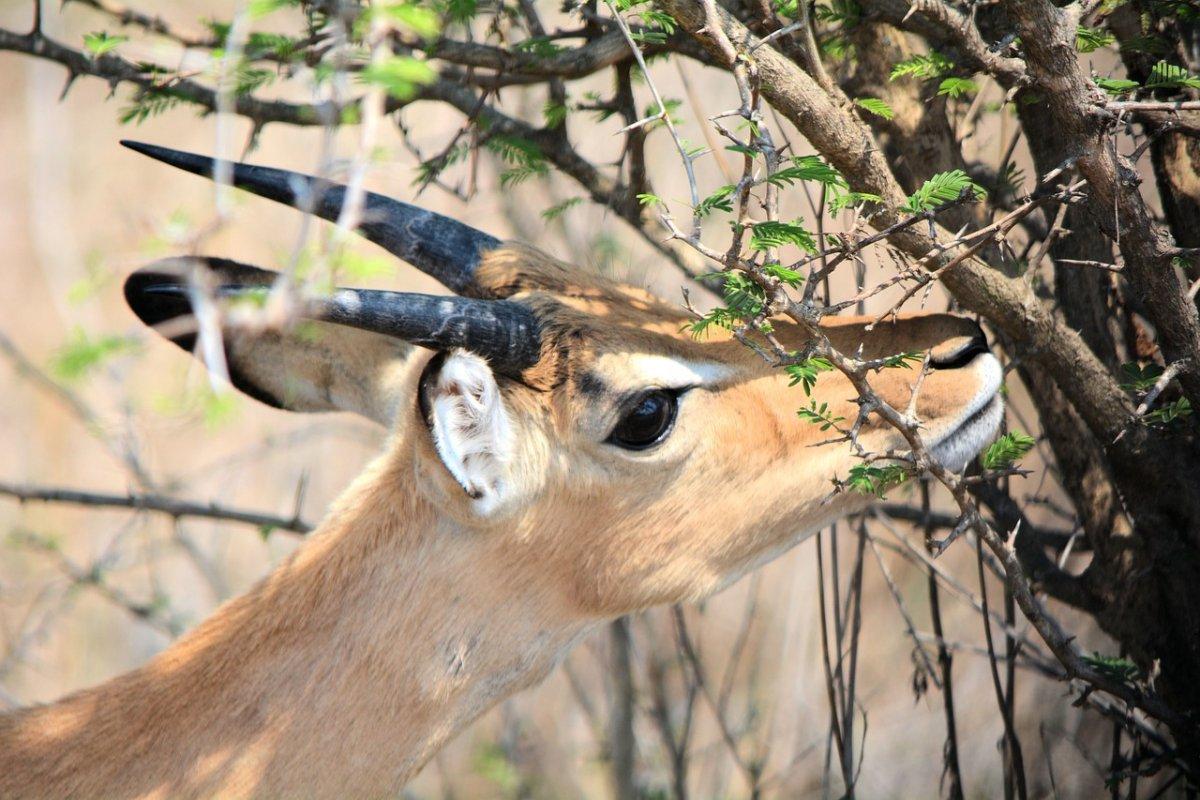
- Name: Southern reedbuck
- Scientific name: Redunca arundinum
- Conservation status:
The southern reedbuck, also known as the common reedbuck or the rietbok, is a species of antelope found in southern Africa. Its coat is almost wooly, and usually light to gray-brown. It lives either alone or in pairs, and rarely forms herds of about 20 individuals.
This antelope can also be found in private land in Zimbabwe, and although it is considered of least concern and is widespread, it has disappeared from parts of its former range, such as the Congo.
19. Yellow baboon
- Name: Yellow baboon
- Scientific name: Papio cynocephalus
- Conservation status:
The yellow baboon is a species of Old World monkey native to the southern part of central Africa. It has a slim body with long legs and arms and is named after its fur, which is entirely yellowish-brown.
This primate is known for its use of vocalizations to communicate, and it often travels as a group, with males leading. Within its ecosystem, the yellow baboon is particularly important due to its seed dispersal behavior.
20. White-backed vulture
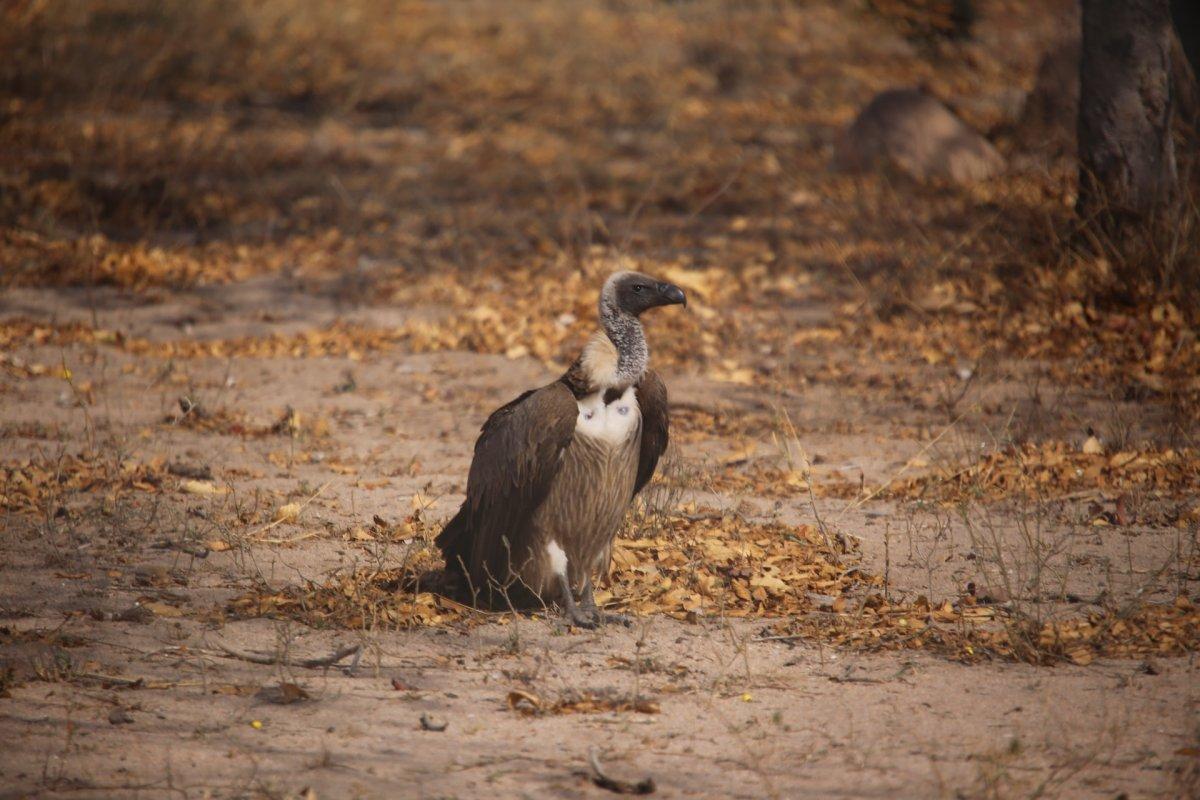
- Name: White-backed vulture
- Scientific name: Gyps africanus
- Conservation status:
The white-backed vulture, also known as the African white-backed vulture, is a large species of Old World vulture native to Africa. In recent years, it has drastically declined, and it is now on the brink of extinction due to persecution, pollution, lead accumulation, and poisoning of carcasses.
This vulture feeds on the large carcasses of gazelles, ostriches, warthogs, zebras, and livestock, and is often seen circling through the sky, looking for freshly dead animals.
21. Martial eagle
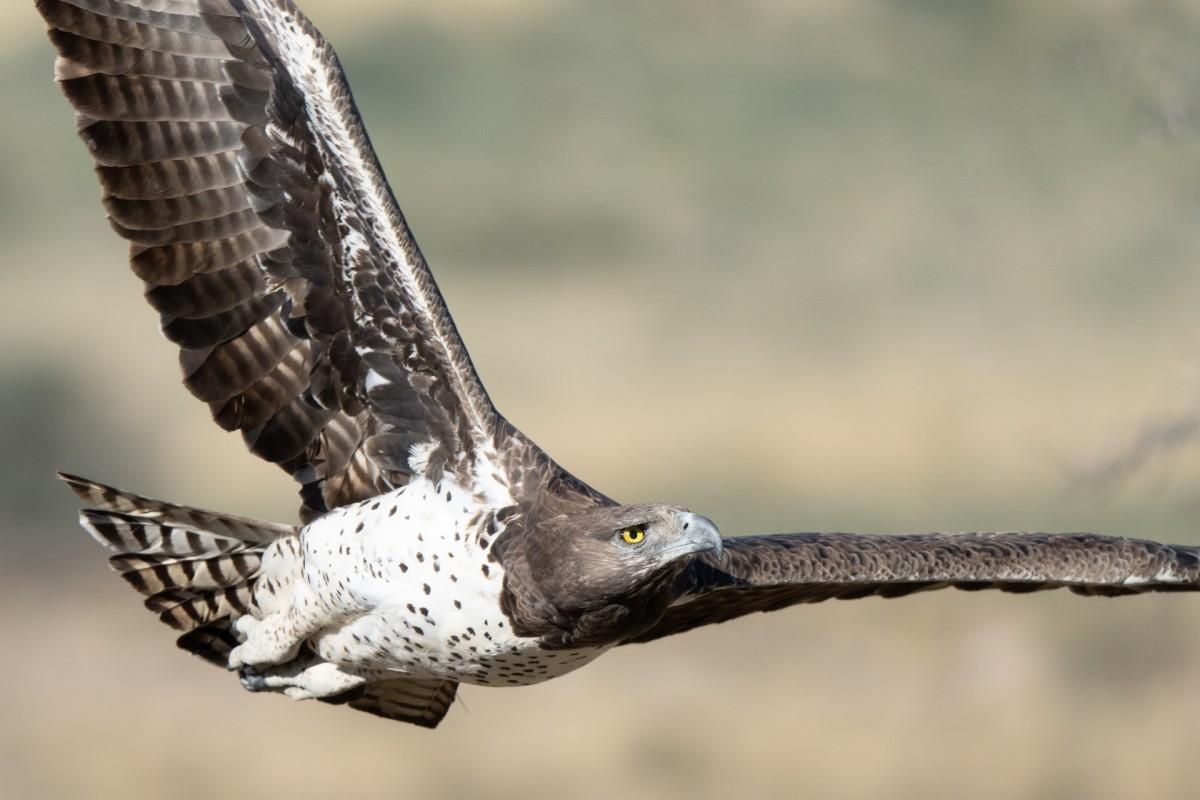
- Name: Martial eagle
- Scientific name: Polemaetus bellicosus
- Conservation status:
The martial eagle is a large species of eagle native to sub-Saharan Africa. Similarly to most other large raptors, it has suffered a continuous decline over the past decades, primarily due to persecution: it is one of the most persecuted birds in the world due to its tendency to attack livestock.
This eagle is particularly large and powerful, but it is a weak vocalizer, even during the breeding season. It can be found at altitudes of up to 3,000 m / 9,800 ft above sea level and prefers open woods and woodland edges.
22. Southern ground hornbill
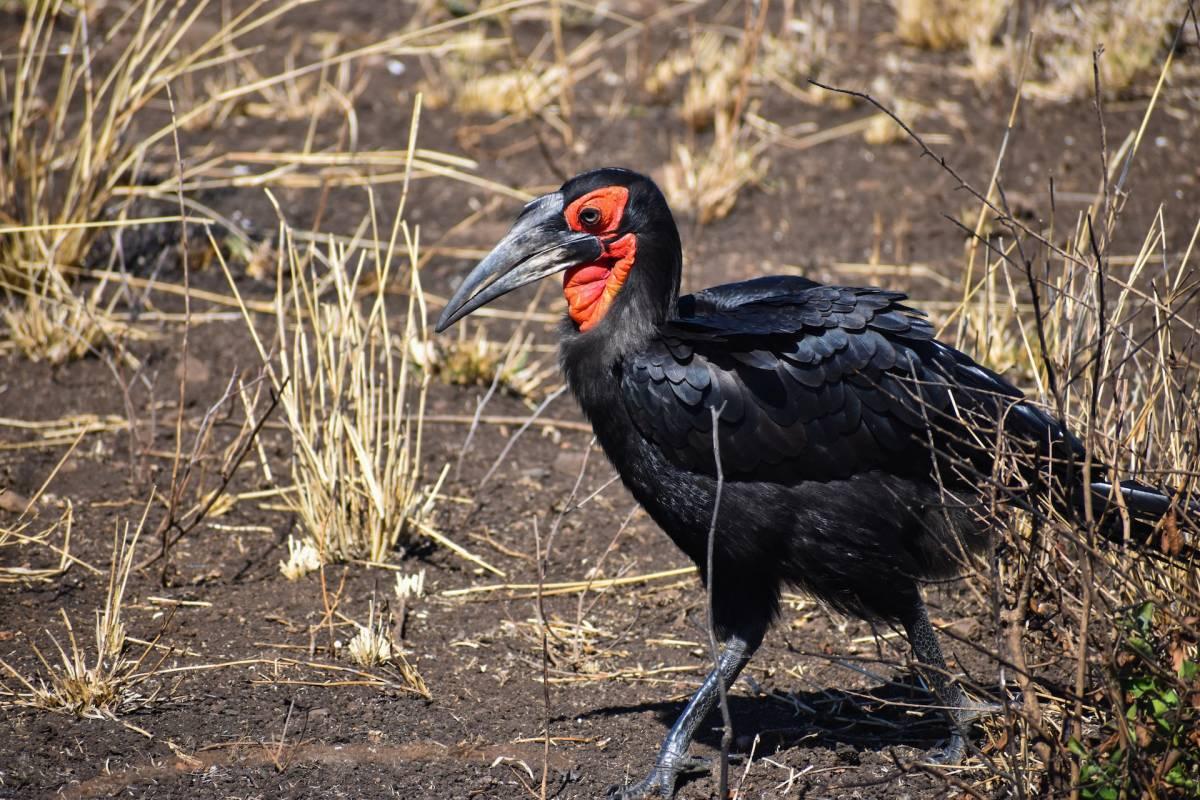
- Name: Southern ground hornbill
- Scientific name: Bucorvus leadbeateri
- Conservation status:
The southern ground hornbill is the largest species of hornbill in the world. It is found from Kenya to South Africa and inhabits savannas and woodlands. It is carnivorous and hunts on the ground for insects and small animals.
This large bird nests in high tree cavities, as well as rock holes in cliff faces. It can live for 50 to 60 years in the wild, and up to 70 in captivity. Despite its name, it can fly.
23. Oriental darter
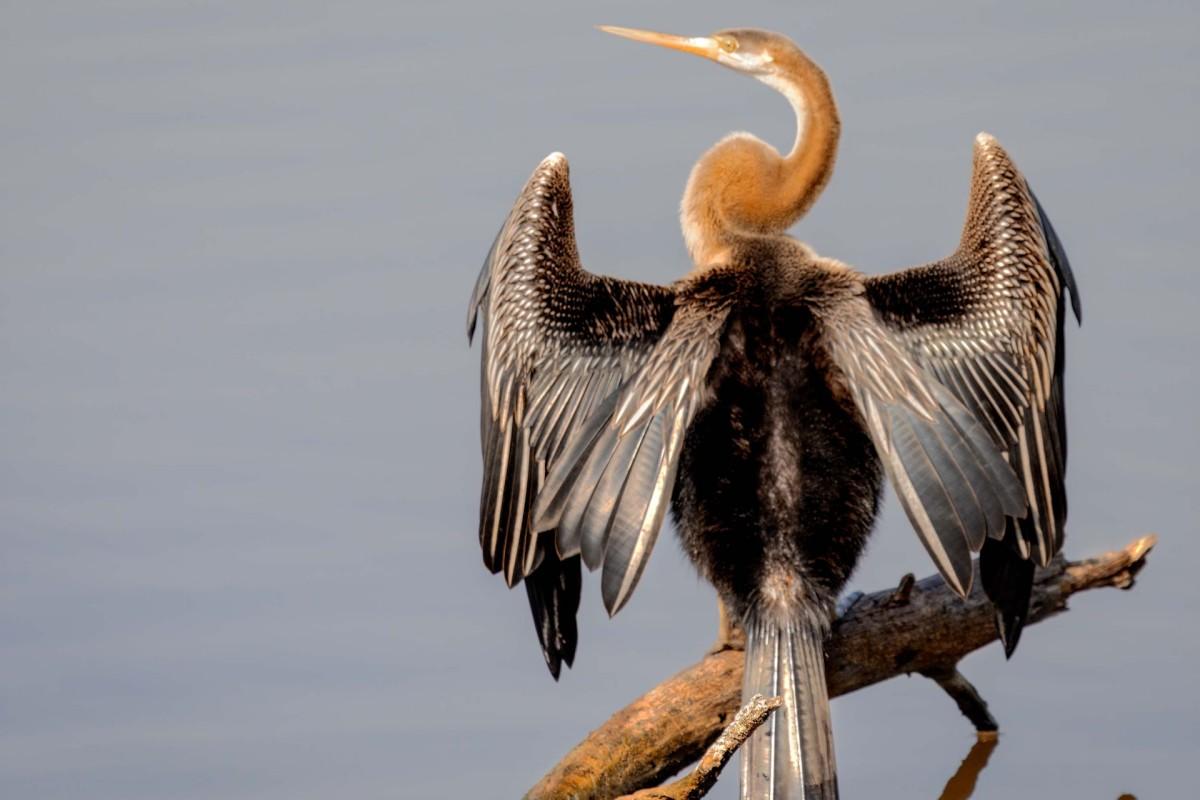
- Name: Oriental darter
- Scientific name: Anhinga melanogaster
- Conservation status:
The Oriental darter, also known as the snakebird, is a species of waterbird native to southern and southeastern Asia, and sometimes found in sub-Saharan Africa. It is well-known for its feeding habits, spearing, juggling, and swallowing fish.
The other name of the Oriental darter comes from the fact that it really looks like a snake when almost fully immersed and looking for food. It is commonly seen on a branch or a rock with its wings held open to dry.
24. Southern white rhinoceros
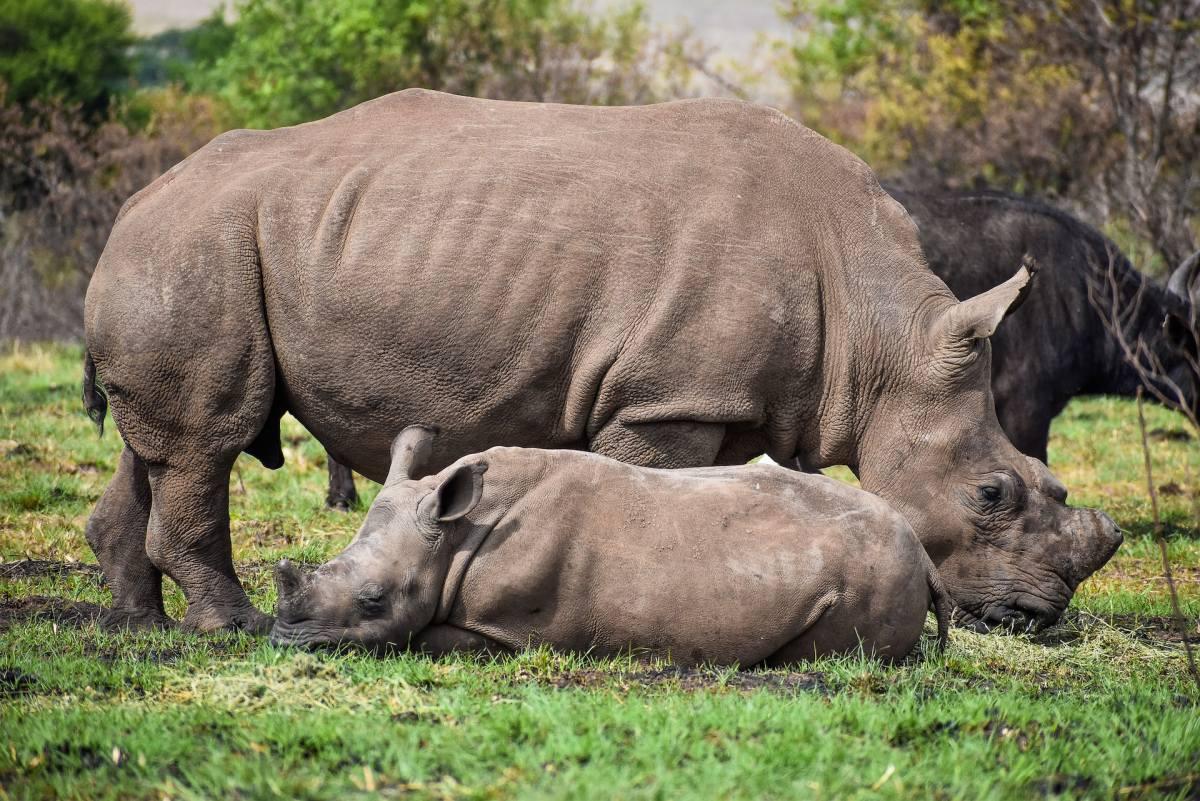
- Name: Southern white rhinoceros
- Scientific name: Ceratotherium simum simum
- Conservation status:
The southern white rhinoceros, also known as the southern square-lipped rhinoceros, is one of two subspecies of the white rhinoceros, much more common than the northern white rhinoceros, which is functionally extinct.
This large mammal can almost exclusively be found in 5 countries: Zimbabwe, South Africa, Namibia, Kenya, and Uganda, and it inhabits the grasslands and savannas of southern Africa. It is threatened by continuous poaching despite being protected, as well as habitat loss.
—
So there you have them, these were my 24 wild animals in Zimbabwe. I hope you enjoyed this list and that you learned something new today.
In case you want to learn more about Zimbabwe wildlife, feel free to keep reading, as I still have lots of things to tell you about:
Endangered Animals of Zimbabwe
This is definitely the saddest part of the list, but it is very important to raise awareness. Because of this, let’s go through the list of endangered animals in Zimbabwe.
Here are the animals in danger of extinction in Zimbabwe.
- None
- White-headed vulture
- Kariba tilapia
- Hooded vulture
- White-winged flufftail
- Black rhino
- and 3 more…
- African wild dog
- African savanna elephant
- Maccoa duck
- Zambezi flapshell turtle
- Nyanga River frog
- And 10 more…
To see the full list of endangered species in Zimbabwe, head over to the International Union for Conservation of Nature’s Red List.
What is the National Animal of Zimbabwe?
The national animal of Zimbabwe is the sable antelope.
The sable antelope is a species of antelope native to wooded savanna in eastern and southern Africa, from Kenya to South Africa, and in Angola. It is herbivorous and feeds on foliage, leaves, herbs, and mid-length grasses, particularly those on termite mounds.
This antelope is particularly sought by trophy hunters and photographers, and despite its peaceful look, it can defend itself pretty aggressively and ruthlessly.
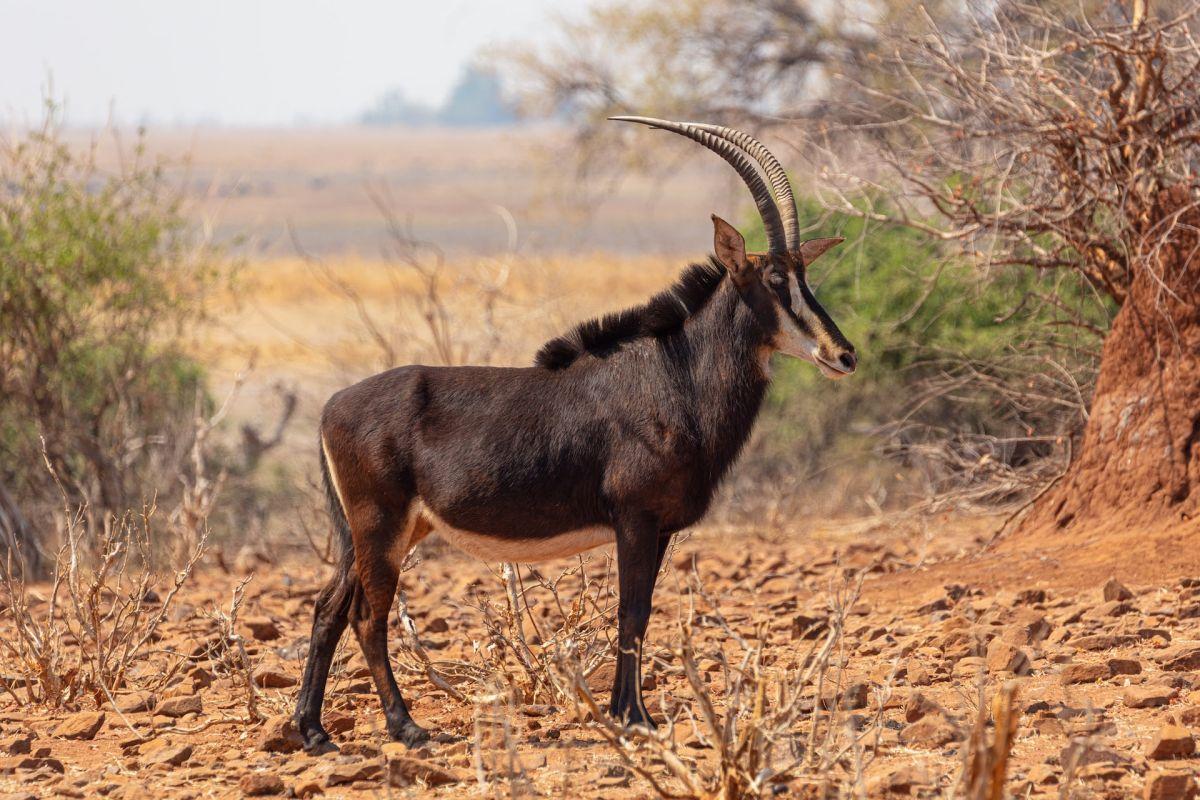
How Many Animals Native to Zimbabwe?
What is the diversity of native animals in Zimbabwe?
Let’s look at the total number of species of Chordata (mammals, birds, fishes, and reptiles).
Total number of animal species in Zimbabwe: 1,253 (14,205 in total in sub-Saharan Africa)
More About Animals in the World!
Loved these Zimbabwe animal facts? Want to see what animals live in other countries?
Then check out these posts:
Or click here to see ALL the facts up on the blog! Spoiler alert: there’s A LOT of them.
Share the knowledge! Click on the buttons below to share information about these animals found in Zimbabwe with your friends, and help them learn more about the world 🙂
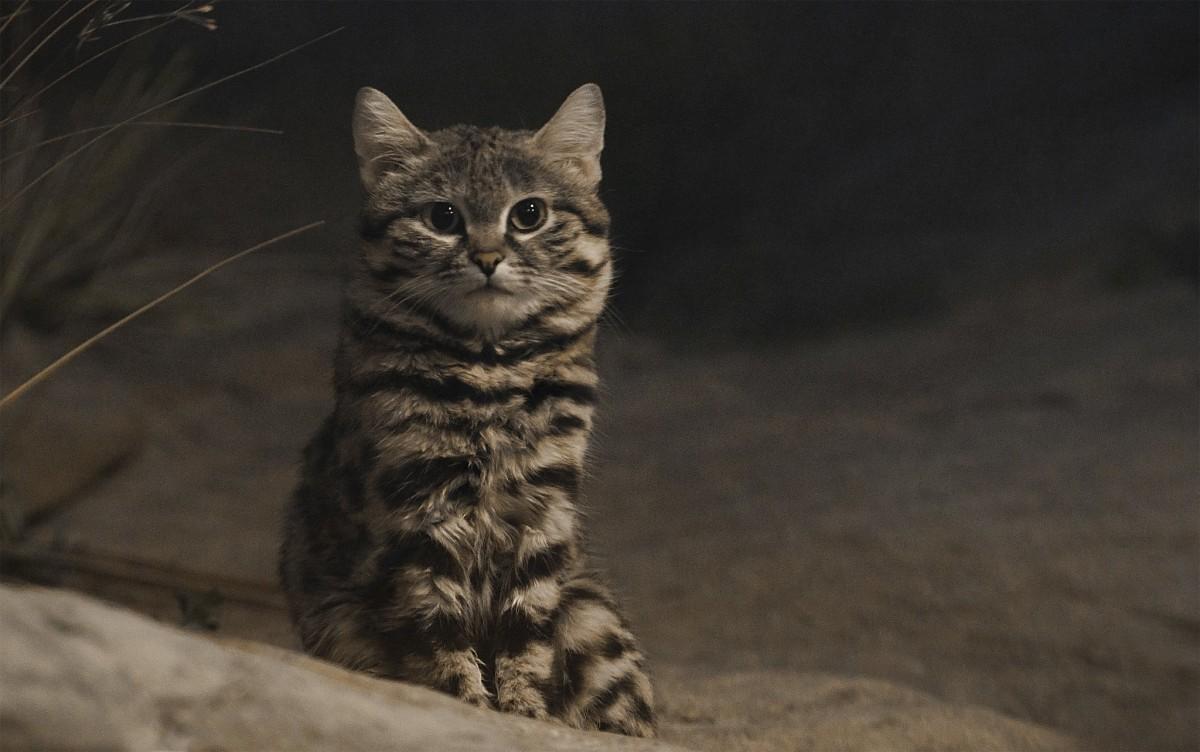
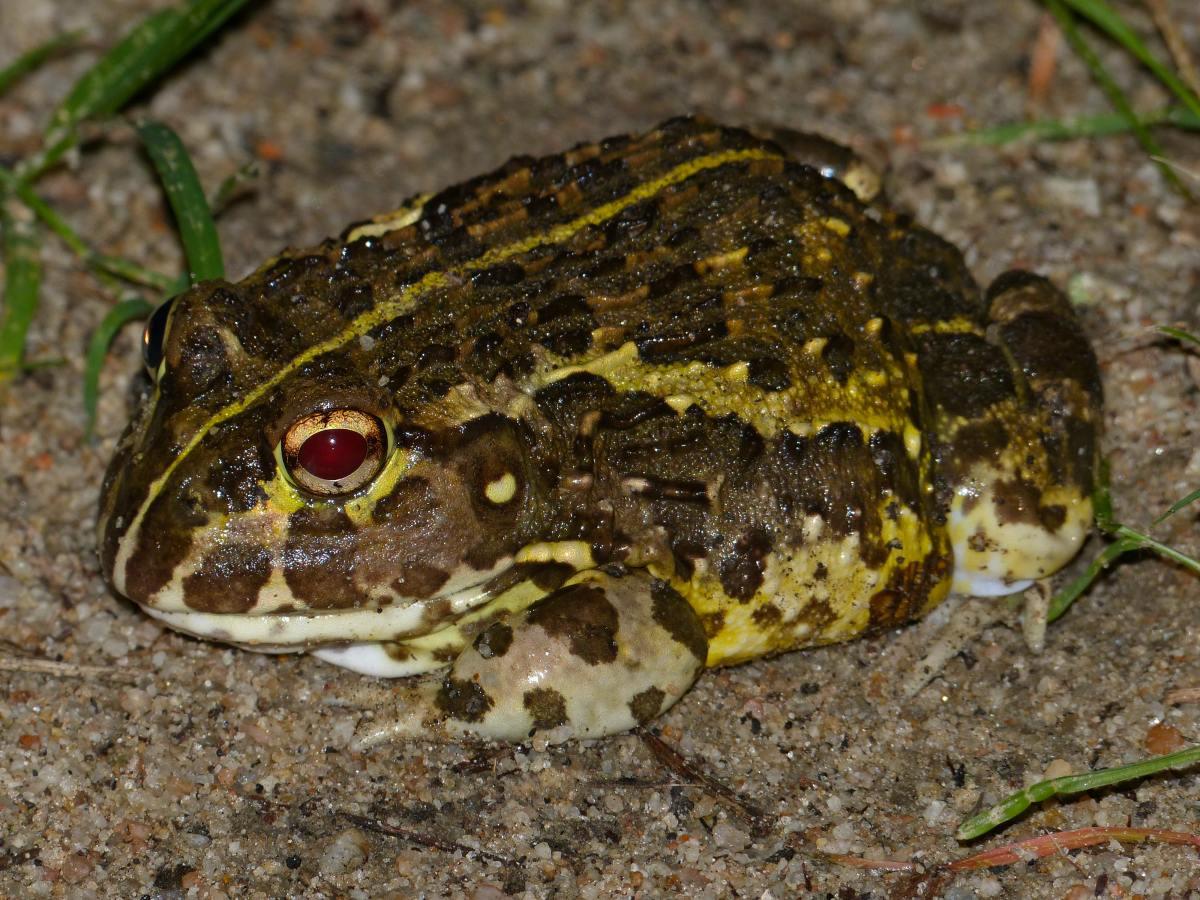
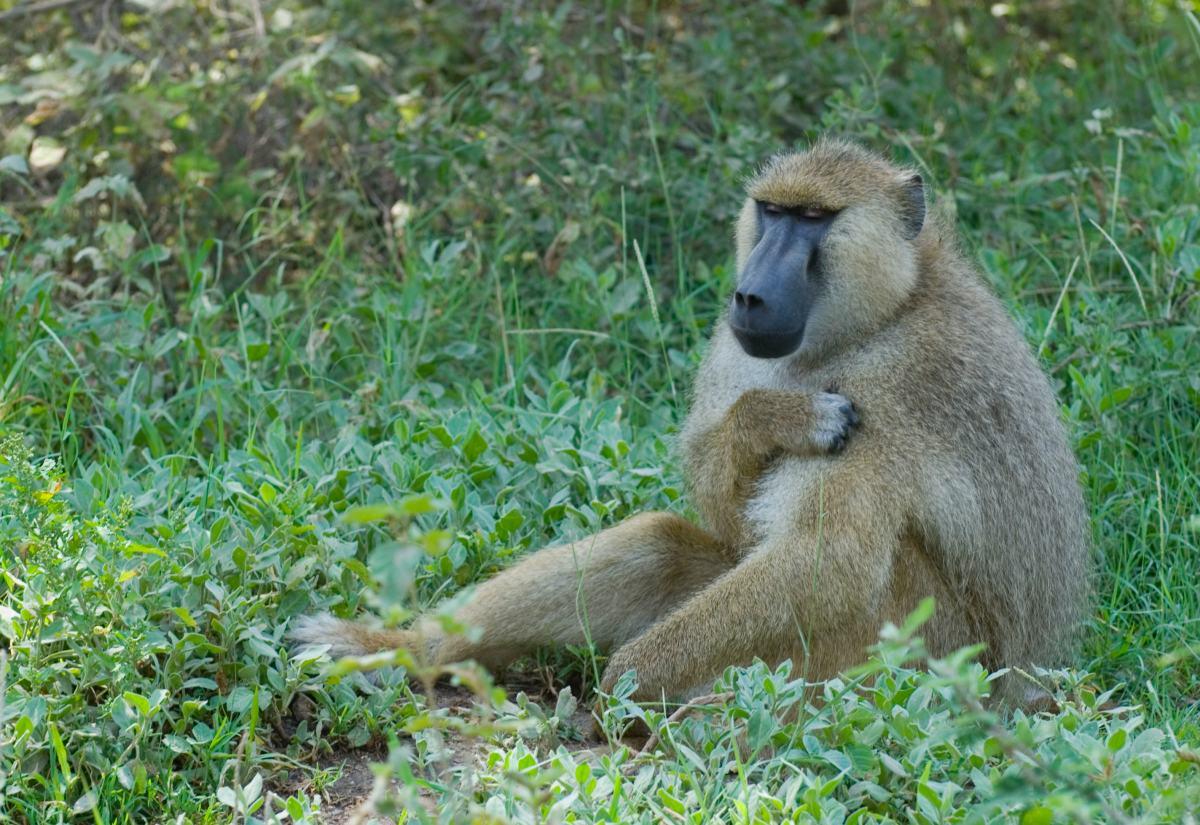

![24 Wild Animals in Mali [Wildlife in Mali]](https://www.kevmrc.com/wp-content/uploads/2022/11/24-wild-animals-in-mali.jpg)
![27 Wild Animals in France [Wildlife in France]](https://www.kevmrc.com/wp-content/uploads/2022/06/27-wild-animals-in-france.jpg)
![18 Wild Animals in Burkina Faso [Wildlife in Burkina Faso]](https://www.kevmrc.com/wp-content/uploads/2022/11/18-wild-animals-in-burkina-faso.jpg)